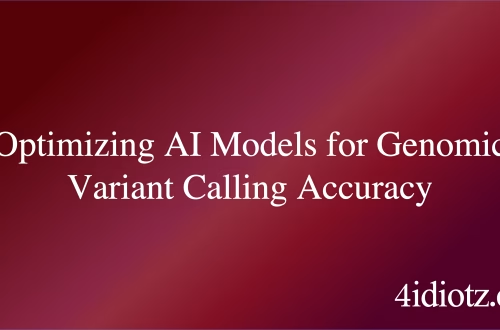Optimizing Explainable AI Models for Molecular Property Prediction
Summary: Molecular property prediction remains a critical bottleneck in AI-driven drug discovery platforms, where traditional “black box” models create regulatory and scientific validation challenges. This article explores technical strategies for implementing explainable AI (XAI) architectures specifically tuned for bioactivity and ADMET prediction tasks, balancing interpretability with predictive performance. We detail hybrid model configurations combining graph neural networks with attention mechanisms, discuss enterprise deployment considerations for pharmaceutical research teams, and provide benchmark comparisons against conventional approaches.
What This Means for You:
- Practical implication: Medicinal chemists can leverage model interpretability features to guide compound optimization cycles rather than relying solely on algorithmic outputs.
- Implementation challenge: Graph-based molecular representations require specialized featurization pipelines and careful hyperparameter tuning to maintain chemical validity while maximizing predictive accuracy.
- Business impact: Explainable models reduce clinical trial failure costs by providing auditable decision trails for regulatory submissions and IP documentation.
- Future outlook: Emerging FDA guidance increasingly mandates algorithmic transparency for AI-supported drug development, making XAI adoption a strategic priority rather than optional enhancement.
The pharmaceutical industry’s adoption of AI for molecular screening faces unique explainability requirements that differ from conventional machine learning applications. Where traditional quantitative structure-activity relationship (QSAR) models provided limited but interpretable insights, contemporary deep learning approaches often sacrifice transparency for performance – a tradeoff that becomes problematic when justifying candidate selection to regulatory bodies or scientific review committees.
Understanding the Core Technical Challenge
Modern drug discovery platforms utilize complex architectures like message-passing neural networks (MPNNs) and transformer-based models operating on molecular graphs. While these achieve state-of-the-art accuracy in predicting bioactivity and pharmacokinetic properties, they typically lack three critical explainability features required for pharmaceutical validation:
- Atom-level contribution mapping showing which structural fragments drive predictions
- Confidence scoring that reflects chemical knowledge boundaries
- Mechanistic plausibility indicators aligning with known biochemical pathways
Technical Implementation and Process
A hybrid architecture combining graph attention networks (GATs) with surrogate interpretability models addresses these requirements through:
- Dual-representation featurization: Simultaneous processing of SMILES strings and 3D conformer ensembles through parallel embedding layers
- Attention-driven explanation: Implementating differentiable attention masks that visualize atomic contribution weights
- Certainty gating: Auxiliary output heads that estimate prediction reliability based on training data coverage
- Post-hoc validation: Automated docking simulation alignment with attention maps for functional verification
Specific Implementation Issues and Solutions
- Challenge: Attention collapse in small molecule prediction: Standard attention mechanisms often fail to provide meaningful atomic resolution for compounds under 500 Daltons. Solution: Implement constrained attention with pharmacophoric priors.
- Challenge: Synthetic accessibility scoring: High-scoring predicted compounds may be chemically impractical. Solution: Integrated retrosynthesis feasibility modules.
- Challenge: Batch effect handling: Discrepancies between different assay sources degrade performance. Solution: Adversarial domain adaptation layers.
Best Practices for Deployment
- Maintain separate explainability servers to prevent performance degradation in production inference pipelines
- Implement chemical sanity checks that flag predictions contradicting established structure-activity relationships
- Use progressive explanation fidelity – from dashboard visualizations to downloadable quantum mechanical analysis
- Establish version-controlled explanation benchmarks using known reference compounds
Conclusion
Successful adoption of explainable AI in drug discovery requires moving beyond generic interpretability techniques to domain-specific architectures. The technical approaches outlined here demonstrate how to maintain predictive performance while delivering the atomic-level insights medicinal chemists require. Pharmaceutical teams prioritizing these implementations gain both regulatory compliance advantages and tangible efficiency gains in lead optimization cycles.
People Also Ask About:
- How do explainable AI models compare to traditional QSAR? Modern XAI architectures achieve comparable interpretability to QSAR while handling complex nonlinear relationships through attention mechanisms rather than predefined molecular descriptors.
- Can these techniques be applied to protein-ligand binding prediction? Yes, through extension to 3D graph representations and interface-focused attention layers, though computational costs increase substantially.
- What minimum dataset size is required? Approximately 500-1000 consistent bioactivity measurements per target are needed for reliable attention pattern emergence.
- How are explanations validated experimentally? Through directed synthesis of attention-highlighted fragments and controlled deletion/mutation studies.
Expert Opinion:
The most effective drug discovery AI implementations balance regulatory requirements with scientific utility through modular explainability architectures. Teams should avoid treating explanations as afterthought visualizations, instead designing them as primary model outputs that inform compound optimization strategies. Investment in chemical-aware explanation benchmarks pays dividends during regulatory review and patent prosecution.
Extra Information:
- Journal of Chemical Information and Modeling Special Issue covers methodological standards for explainable AI in pharmaceutical applications
- Chemprop Framework provides open-source implementations of explainable graph neural networks for molecular property prediction
Related Key Terms:
- Attention mechanisms for molecular graph interpretation
- Validating AI drug discovery model explanations
- Hybrid QSAR-deep learning architectures
- Regulatory compliance for pharmaceutical AI
- Atomic contribution mapping techniques
- Confidence estimation in bioactive molecule prediction
- Implementing explainable AI in drug discovery platforms
Check out our AI Model Comparison Tool here: AI Model Comparison Tool
*Featured image generated by Dall-E 3





